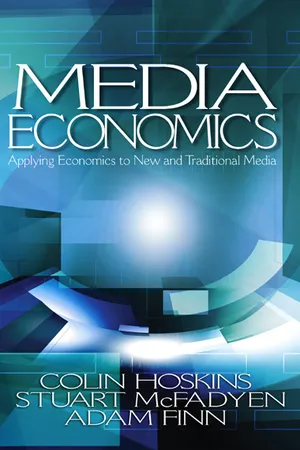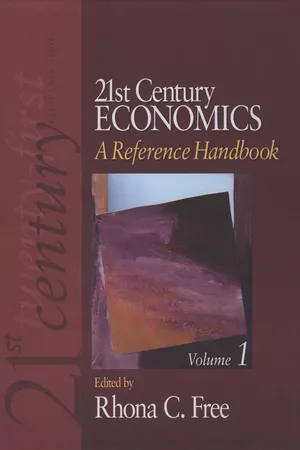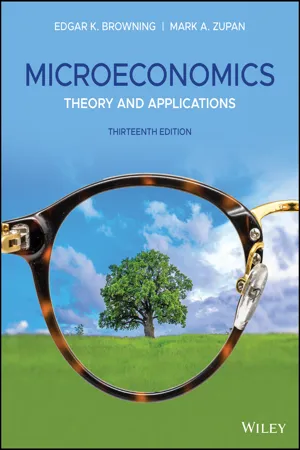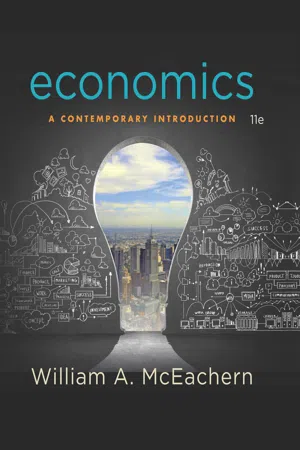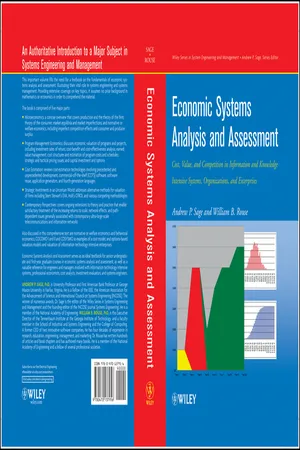Economics
Short Run Output
Short run output refers to the level of production a company can achieve in the short term, typically with at least one fixed input. It is influenced by factors such as labor, capital, and technology. In the short run, a company may not be able to adjust all inputs, leading to a limited capacity to increase output.
Written by Perlego with AI-assistance
Related key terms
1 of 5
8 Key excerpts on "Short Run Output"
- eBook - ePub
Media Economics
Applying Economics to New and Traditional Media
- Colin Hoskins, Stuart McFadyen, Adam Finn(Authors)
- 2004(Publication Date)
- SAGE Publications, Inc(Publisher)
economically efficient ; there must be no other method available that is capable of producing the output for a smaller total value (cost) of inputs. Total cost depends on the number of each factor employed and the price per unit that the firm has to pay.5.1 Short Run, Long Run, and Very Long RunProduction opportunities—ways of combining inputs to change output—differ according to the length of time considered. The quantities of some inputs can be changed very rapidly, whereas a considerable time is needed to change others. For example, energy use can be changed by the turn of a switch, whereas building a plant or installing machinery is likely to take months or even years.The short run is defined as a time period insufficient to change the input level of items such as capital equipment and plant. Such capacity factors are fixed in the short run. However, quantities of inputs such as labor and raw materials can be changed and are thus variable factors even in the short run.The long run is a period of sufficient length that all factors of production are variable, but the basic technology of production is given.The very long run is a period during which the technological possibilities available to the firm may also change.5.2 Production in the Short RunA production function shows the maximum quantity of a product that can be produced in a time period for each set of alternative inputs. In the short run, the production function is governed by the Law of Diminishing Returns . This law states that after a certain level of input of the variable factor, each additional unit of the variable factor, employed in conjunction with a fixed quantity of another factor, adds less to total product than the previous unit. (In production theory, economists use the word “product” to mean “output”; the words are used interchangeably).The law is stated as if there were only two factors, one variable and the other fixed, but this is a simplification; the law applies for any number of variable and fixed factors. Also, note the similarity between the Law of Diminishing Returns and the Law of Diminishing Marginal Utility. - eBook - PDF
- Rhona C. Free(Author)
- 2010(Publication Date)
- SAGE Publications, Inc(Publisher)
Firms get created and enter industries in the long run. Similarly, companies go out of business, liquidate all their assets, and exit from industries in the long run. There is no set length of time that separates the short from the long run; it depends on the nature of the firm and its produc-tion process. For a small corner convenience store, the long run may be months. For a large corporation, with many factories, it may be years. The discussion immedi-ately below focuses on the short run; the long run will be considered subsequently. Marginal Analysis To explain the relationship between inputs and output, assume that the firm varies one input at a time and holds all its other inputs constant. All firms need to know how productive their inputs are. That is, they need to know how much an additional input will add to output (and revenue) and how much it will cost to hire (or purchase) that input. This so-called marginal analysis, or decision making at the margin, lies at the heart of all economic decisions. Firms, as well as consumers, are always dealing with finite bud-gets and asking themselves, Is it worth it? Economists use the phrase, ceteris paribus, or all other things unchanged, when discussing decisions made at the margin. It is con-venient, therefore, to consider a short run with only one variable input. TP, Q 1,800 1,600 1,400 1,200 α 1,000 -| & 800 600 400 200 0 20 40 60 80 100 120 140 160 180 200 220 Hours (a) AP MP 20-1 18 16 Η 14 1 2 -| /v. 10 8 Η 6 4 2 Η 0 -I 1 1 1 Τ-Ο Ο Ο Ο Ο O Q Q Ö O O O O O -2 > -c m Η IF IN -SM Η Hours (b) Figure 10.1 Short-Run Output-One Variable Input: (a) Total Product; (b) Marginal and Average Product Consider panel (a) in Figure 10.1. This diagram illus-trates the firm's quantity of output (Q) or total product (TP) in the short run, with one variable input, labor. Labor is assumed to be homogeneous and is measured as the hours of labor that the firm uses with its other fixed factors of pro-duction. - eBook - PDF
Microeconomics
Theory and Applications
- Edgar K. Browning, Mark A. Zupan(Authors)
- 2019(Publication Date)
- Wiley(Publisher)
This chapter explains how economists represent the technological possibilities available to the firm. The productivity of inputs is an important determinant of output: it specifies how much can be produced. As we will see in later chapters, the productivity of inputs underlies both the cost curves of the firm and the firm’s demand curves for inputs. Learning Objectives • Establish the relationship between inputs and output. • Define total, average, and marginal product, and explain the law of diminishing marginal returns in the short-run setting when at least some inputs are fixed. • Investigate the ability of a firm to vary its output in the long run when all inputs are variable. • Explore returns to scale: how a firm’s output response is affected by a proportionate change in all inputs. • Describe how production relationships can be estimated and some different potential functional forms for those relationships. • Production When Only One Input Is Variable: The Short Run 161 Relating Output to Inputs Inputs—sometimes called factors of production—are the ingredients mixed together by a firm through its technology to produce output. For example, a motion picture studio uses inputs such as producers, directors, actors, costume and sound designers, technicians, and the capital invested in its lots, sound stages, and equipment to produce movies. Inputs may be defined broadly or narrowly. A broad definition might categorize all inputs as either labor, land, raw materials or capital. When considering some questions, however, it may be helpful to use more narrow subdivisions within the broader categories. For example, the labor inputs employed by a firm might include engineers, accountants, programmers, sec- retaries, and managers. Raw materials may involve electricity, fuel, and water. Capital inputs may include buildings, trucks, robots, and automated assembly lines. - eBook - ePub
- Israel M. Kirzner(Author)
- 2015(Publication Date)
- University of Chicago Press(Publisher)
Our interpretation of the distinction between costs of shorter and of longer run is not unrelated to the common usage (cited above under point 1) in which the term long run refers to a span of time sufficient for all adjustments to take effect. As a matter of empirical fact, it is likely that the earlier steps in the sequences of production decisions (such as the construction of plant) will be undertaken relatively infrequently—precisely because once a factory has been constructed, it represents a costlessly available resource. Thus the effect of a change in long-run costs, such as an increase in plant construction, will be felt in the market only as longer and longer periods of time are considered. In the short run, only changes in short-run costs will manifest themselves in the form of changed output and price patterns.It will be observed, moreover, that this interpretation of the distinction between long-run and short-run costs is in some respects similar to the common usage (cited in the preceding section under heading 2) distinguishing between long-run and short-run profits. In both usages, “long run” considerations require attention to the relevant magnitudes for the entire length of a prospective long period of time. However, it will be noticed that the “shortness” relevant to “short-run profits” is of a different kind from that relevant to “short-run costs.” In the case of short-run profits it is imagined that, for some unexplained reason, the horizon of the firm is so near that the only receipts and outflows relevant to the calculation of profit are those anticipated in the near future. In the case of our short-run costs, on the other hand, the explanation for confining attention to the sacrifices anticipated during the near future only is a simple one—namely, that the production goal can in fact be achieved in the near future, since all necessary earlier steps have already been taken and call for no present sacrifice.That earlier writers have generally overlooked this kind of distinction between long-run costs and short-run costs seems to reflect an unwillingness to accept the possibility of more than one answer to the question: “What did it cost to produce a given product?” Consequently, the difference between the long-run cost of producing a given product and its short-run cost has been sought in the different circumstances under which the product may be produced, such as the time available for production, or the kinds of expectations held when production is undertaken. For my part I have found it entirely understandable that the cost of producing a given product turns out to be of one magnitude when referred back to the earliest in a long past sequence of decisions and of a different magnitude when referred back to another decision in that sequence. - eBook - PDF
- Steven Landsburg(Author)
- 2013(Publication Date)
- Cengage Learning EMEA(Publisher)
6.3 Relations between the Short Run and the Long Run In Section 6.1, we studied the firm ’ s short-run production function and cost curves; in Section 6.2, we studied the firm ’ s long-run production function and cost curves. Our remaining task is to relate the two points of view. From Isoquants to Short-Run Total Cost Consider a firm that rents capital at a rate of P K ¼ $10 and hires labor at a rate of P L ¼ $15. The firm ’ s production function is illustrated in Exhibit 6.13. Its capital is fixed in the short run at 5 units (thus, if a “ unit ” is a machine, the firm has the use of 5 machines; if a “ unit ” is 100 square feet of office space, the firm has the use of 500 square feet). In the short run, the firm can only choose input baskets that contain exactly 5 units of capital, which is to say that it can only choose baskets that are located on the blackened horizontal line. To produce 5 units of output, it must select a basket that is both on this line and on the 5-unit isoquant; that is, it must select the point with 5 units of capital and 1 unit of labor. The firm ’ s total cost is then 6 This argument assumes that the firm can hire all of the inputs that it wants to at a going market price. Without this assumption, the long-run average cost curve could be increasing even in the presence of increasing returns to scale. The same caveat applies to all of our arguments in this subsection. 156 CHAPTER 6 Copyright 2014 Cengage Learning. All Rights Reserved. May not be copied, scanned, or duplicated, in whole or in part. Due to electronic rights, some third party content may be suppressed from the eBook and/or eChapter(s). Editorial review has deemed that any suppressed content does not materially affect the overall learning experience. Cengage Learning reserves the right to remove additional content at any time if subsequent rights restrictions require it. 5 $10 ¼ $50 for capital plus 1 × $15 ¼ $15 for labor, or $65. - eBook - PDF
Microeconomics
A Contemporary Introduction
- William A. McEachern(Author)
- 2016(Publication Date)
- Cengage Learning EMEA(Publisher)
Due to electronic rights, some third party content may be suppressed from the eBook and/or eChapter(s). Editorial review has deemed that any suppressed content does not materially affect the overall learning experience. Cengage Learning reserves the right to remove additional content at any time if subsequent rights restrictions require it. Chapter 7 Production and Cost in the Firm 153 7-4 Costs in the Long Run So far, the analysis has focused on how costs vary as the rate of output increases in the short run for a firm of a given size. In the long run, all inputs that are under the firm’s control can be varied, so there is no fixed cost. The long run is not just a succession of short runs. The long run is best thought of as a planning horizon . In the long run, the choice of input combinations is flexible. But once the size of the plant has been selected and the concrete has been poured, the firm has fixed costs and is operating in the short run. Firms plan for the long run, but they produce in the short run. We turn now to long-run costs. 7-4a Economies of Scale Recall that the shape of the short-run average total cost curve is determined primarily by increasing and diminishing marginal returns from the variable resource. A differ-ent principle shapes the long-run cost curve. If a firm experiences economies of scale , long-run average cost falls as the scale of the firm expands. Consider some sources of economies of scale. A larger firm size often allows for larger, more specialized machines and greater specialization of labor. For example, compare the household-size kitchen of a small restaurant with the kitchen at a McDonald’s. At low rates of output, the smaller kitchen produces meals at a lower average cost than does McDonald’s. But if produc-tion in the smaller kitchen increases beyond, say, 100 meals per day, a kitchen on the scale of McDonald’s would make meals at a lower average cost. - eBook - PDF
Economics
A Contemporary Introduction
- William A. McEachern(Author)
- 2016(Publication Date)
- Cengage Learning EMEA(Publisher)
Due to electronic rights, some third party content may be suppressed from the eBook and/or eChapter(s). Editorial review has deemed that any suppressed content does not materially affect the overall learning experience. Cengage Learning reserves the right to remove additional content at any time if subsequent rights restrictions require it. Chapter 7 Production and Cost in the Firm 153 7-4 Costs in the Long Run So far, the analysis has focused on how costs vary as the rate of output increases in the short run for a firm of a given size. In the long run, all inputs that are under the firm’s control can be varied, so there is no fixed cost. The long run is not just a succession of short runs. The long run is best thought of as a planning horizon. In the long run, the choice of input combinations is flexible. But once the size of the plant has been selected and the concrete has been poured, the firm has fixed costs and is operating in the short run. Firms plan for the long run, but they produce in the short run. We turn now to long-run costs. 7-4a Economies of Scale Recall that the shape of the short-run average total cost curve is determined primarily by increasing and diminishing marginal returns from the variable resource. A differ- ent principle shapes the long-run cost curve. If a firm experiences economies of scale, long-run average cost falls as the scale of the firm expands. Consider some sources of economies of scale. A larger firm size often allows for larger, more specialized machines and greater specialization of labor. For example, compare the household-size kitchen of a small restaurant with the kitchen at a McDonald’s. At low rates of output, the smaller kitchen produces meals at a lower average cost than does McDonald’s. But if produc- tion in the smaller kitchen increases beyond, say, 100 meals per day, a kitchen on the scale of McDonald’s would make meals at a lower average cost. - eBook - ePub
Economic Systems Analysis and Assessment
Intensive Systems, Organizations,and Enterprises
- Andrew P. Sage, William B. Rouse(Authors)
- 2011(Publication Date)
- Wiley-Interscience(Publisher)
CHAPTER 2 PRODUCTION AND THE THEORY OF THE FIRM 2.1 INTRODUCTIONWe will use the word production or productivity in a very general sense to denote all activities that satisfy consumer demand for goods and services. In the classic use of the term, production is associated with the use of natural resource inputs to produce finished products that are subsequently marketed to consumers through various service efforts. In the initial part of this book, we will be concerned with this classic interpretation. In the later part, we will also consider production of inherently information and knowledge intensive products, such as software. Production is therefore one of the basic components of microeconomic theory. A (classic) firm is a unit that uses natural resource inputs, capital, and labor to produce output goods or services for purchase by consumers. The economic problem faced by a production unit or a firm is that of determining the quantity of output to produce and the amounts of the various input factors to be used in the production process. This will depend, of course, on technological relationships between the prices or costs of input factors, or input supplies, and the price that can be obtained for the output quantity, which is a function of the demand for the product of the firm. This is a problem in resource allocation that involvesFigure 2.11. the technology of the production process or the production function,2. the price, or equivalently costs, of the input resource quantities or input factors such as labor, natural resources, and capital, and3. the price of and demand for the output quantity.
Index pages curate the most relevant extracts from our library of academic textbooks. They’ve been created using an in-house natural language model (NLM), each adding context and meaning to key research topics.
